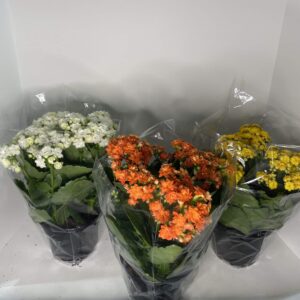Kalanchoes, native to Madagascar, are easy-care, flowering succulent plants that do extremely well indoors. A relative of the jade plant, kalanchoes are short, bushy, upright plants with thick, oval-shaped scalloped leaves.
These are great indoor plants to perk up your home during the long winter months. The shorter the days, the more flowers kalanchoes produce. Best of all, the blooms on kalanchoe plants may last up to 8 weeks.
Kalanchoe plants need bright indirect light and can even tolerate direct sun during the fall, winter, and spring. Direct sun in the summer is too intense and burns the leaves. The blooms on kalanchoe plants are photo-periodically induced. As the days get shorter and kalanchoes experience longer periods of darkness, they produce more flowers.
Kalanchoes are Succulent Plants with plump leaves that store water for long periods of time. These plants are easily over-watered which causes root-rot. Always allow the top 50% of the soil to dry-out before watering. If the soil is exceptionally dry, sit the plant in a deep saucer of water for about ten minutes. This not only prevents over-watering but keeps the leaves dry. Wet leaves encourage plant diseases such as leaf spot or powdery mildew.
Indoor kalanchoe plants like warm temperatures between 60°-85°F (15.6°-18.3°C). Low temperatures below 40°F (4.4°C) can damage or kill a kalanchoe within a few hours. Keep kalanchoes away from cold drafts and open windows during the winter.
Kalanchoes grow well in regular to low household humidity. When the humidity is too high, these plants develop plant diseases such as leaf spot or powdery mildew.
Remove faded blooms as soon as they appear to encourage more flowers. Starting in October, keep a kalanchoe plant in total darkness at night for up to 14 hours and then place it in bright indirect light during the day. This encourages the plant to flower.
Kalanchoe houseplants are fairly pest resistant.
Kalanchoes are available in 4″ and 6″ pots. They rarely need to be in a container larger than 8” wide and 6” deep. Kalanchoe containers must have drip holes in the bottom so excess water can drain out.

